I’ve been in the middle of a major office/workspace reorganization and cleanup, which is one of the reasons I haven’t posted too much this past week. I’m almost done, and I’ll show you the terrific results when I am, but in the meantime I wanted to share these fabric covered bulletin boards I made to help keep me organized.
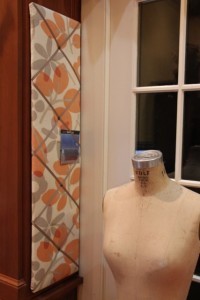
I’ve made a bunch of these over the years, but this time I came up with a new twist: I screwed some sheet metal I cut to size onto the plywood, which makes the top 2/3 (or however much you want) of the board magnetized!
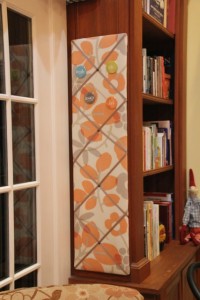
What I love about bulletin boards like these is you can make them to exactly the size that you need. I happened to have the outside of two built-in bookcases available, which will be right between where I plan on putting my new worktable. Because of this available space, the boards I needed to make were long and skinny – 42″ long by 10-1/2″ wide to be exact. I found a cute contemporary floral I loved. That it didn’t go with my curtains didn’t really bother me, as after almost 14 years of living with these curtains I’m so sick of them I could scream.
This is one of those projects that if you’re making one, you may as well just get a little bit extra fabric, ribbon and board and make another one too — give one as a gift, make one for your kids — but maybe that’s just me.
What you’ll need:
- Plywood cut to the size you need
- Enough fabric to completely cover your board, so add about 3″ on all 4 sides to your board measurement to get the size of the fabric piece you’ll need.
- Sheet metal (I got a 12″x24″ sheet of zinc metal at Home Depot for $6.97)
- Large saw-tooth picture hanger
- Sheet quilting batting (I used cotton)
- Gro-Grain ribbon – you’re going to have to measure to see how much you’ll need, and this will depend on how you space your X’s.
- Fabric marking chalk or pencil
- Decorative upholstery nails to tack down the ribbon at it’s center-point
- Staple gun with 1/2″ staples
- Hammer
- Scissors
- Screwdriver
Cut the plywood to the size board you want. Maybe Rachel Garza (my fellow County Living Blue Ribbon Blogger Award winner) and I should get together and do a “women and power tools” ad for Craftsman or something?

I clamped my sheet metal onto the board exactly where I wanted it, drew a line with a sharpie to aid in my cutting, and used a hacksaw to cut it to the proper size. I did this over my sink so as not to get metal fragments anywhere. Clamping or taping the metal to a board just gives it a solid surface to cut on and will make your cutting much easier.
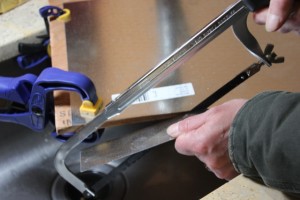
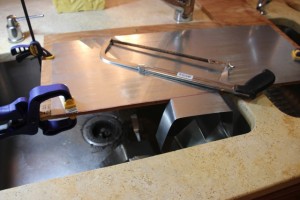
Drill holes in the corners of the sheet metal and screw metal sheet to plywood. My screws were too long, so I used my hacksaw to cut the backs off.


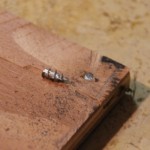
If you are using sheet metal on your board, you’ll need to mark off ribbon placement and drill center hole before covering with the batting and fabric. Use a small drill bit just barely the size of your upholstery nail shank, but drill all the way through to the back of the board, as you’ll need this hole later to find the correct corner spot for the upholstery nail of the front of your board. If you try and drill the center hole once the fabric is on you run a great risk of pulling or ripping the fabric with the drill. As you can see here, I played around a bit with my placement before finally marking it off in 4 equal distances, making it only one “X” wide. If you have a wider board you will cross-cross several times across it.
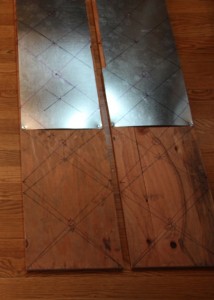
Mark off ribbon placement and drill center hole before covering with the batting and fabric.
Cut your quilting batting so that it’s about 2″ larger than the wood on all 4 sides. To make sure the magnets still work through the batting, I used a single layer of batting over the sheet metal and a double layer over the plain wood area. Learn from my mistakes — the first one I made I used a double layer over the whole board, and magnets aren’t strong enough to work through 2 layers. Pull the batting tight as your work around the board, stapling the batting to the wood every 5 inches or so. Hammer staples all the way down if necessary.

Cut quilting batting so that there is a single layer over the sheet metal area and a double layer over the plain wood.

Pull the batting tight as your work around the board, stapling the batting to the wood every 5 inches or so. Hammer staples all the way down if necessary.

Now your board is ready to cover with the fabric.
I used some Heat-n-Bond iron on hem tape to give the fabric a quick hem all around. This not only makes it look neater on the backside, but also give the staples more fabric to hold on to as you are stapling the fabric to the board.

Use Heat-n-Bond to give your fabric a quick hem all around.
Place your hemmed and ironed fabric with the right side facing down on your work surface and lay your board, right side down, on top of the fabric. Starting at the top and bottom, pull your fabric taught, but not so tight that you stretch out the pattern of the print, and using your staple gun, staple it every few inches to the back of the board. Hammer the staples in completely if necessary.
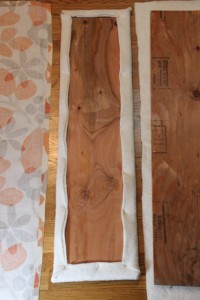
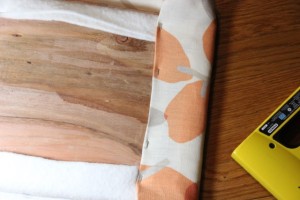
Pulling the fabric taught, staple the fabric to the back of the board.
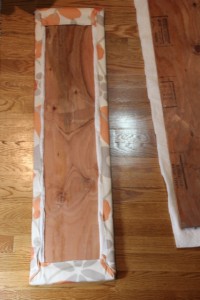
And now for the ribbon. Using fabric marking chalk, mark the measurements on your fabric that you determined earlier, top, bottom and center “X” of your squares. You can check to see if you’re measurements are accurate by inserting a needle through the back of the board through to the front in the drill holes that you made at the center “X” positions on the sheet metal earlier. Fold ribbon over at the end to double it at the staple point, staple it to the back side of the board. Pulling ribbon tight and sticking to the chalked marking lines, fold ribbon over and staple the end down on the backside of the board. Repeat with the next ribbon to complete the X. Continue as above with all of your marked squares.
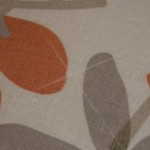

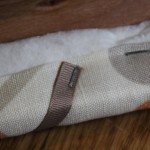
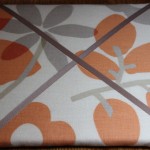

Now to put the upholstery tacks in the center “X” of the ribbons. Use a needle through the back of the board if you need to. Hammer in your upholstery tacks. If you find it’s not tight because of the pre-drilled hole, you can put a little glue on the shank of the tack, nail it back in, and put something heavy on it while the glue dries. I had to do this.
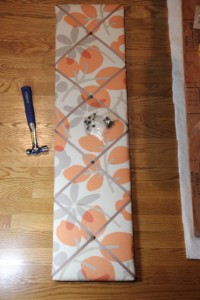
Nail on a large saw-tooth picture hanger onto the back near the top of the board, and you’re done!

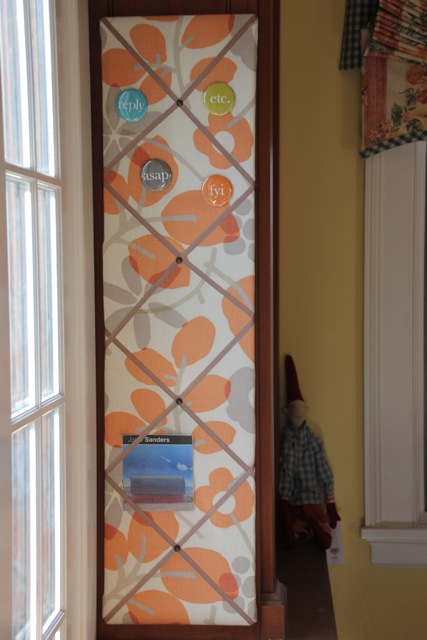
As a final note, I had these cute magnets that I’d bought ages ago and finally could use, but they had weak magnets that didn’t work on this board. I found these “amazingly strong” magnets on clearance at Restoration Hardware, and glued two onto the backs of the magnets and now they work great. You can find super-strong magnets at lots of places and online if you run into the same situation.

Love this idea. When my husband and I return north in 5 or so weeks, it is my intention to move my studio space from the basement to a bright and airy 2nd floor room. My head is swimming with ideas, but I need to keep myself grounded in financial reality! I’m looking forward to seeing your space completed!